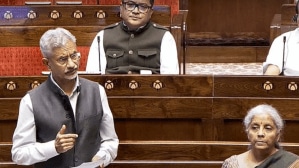From dumpyard to biodiversity park: How this 10-acre plot of land in Greater Noida underwent a transformation
The landfill, an eyesore, was an embarrassment for the residents
 The biodiversity park in Sector 16- from left, before and present images (Express)
The biodiversity park in Sector 16- from left, before and present images (Express)Peepal, Neem, Banyan, Ashoka, and Teak — trees of all kinds offer comfort in their shade to visitors on a hot and humid afternoon. Two gardeners can be seen walking between plants, watering them. Not too far, a pair of birds are busy flying twigs to their nest.
Just seven months back, this 10-acre land near the Sector 16 Railway Bridge in Greater Noida — where the trees now stand tall — was a dumping ground where waste, illegal mining pits, and toxic fumes sparked health concerns for residents. The efforts of SAFE (Social Action for Forest and Environment), a local nonprofit, and the support of the Greater Noida Industrial Development Authority (GNIDA) and Noida Power Company Limited (NPCL) transformed it into a green ecosystem.
“The area had deteriorated due to illegal soil mining, and dumping of untested liquid waste from Ghaziabad, and municipal solid waste from nearby societies,” said SAFE founder Vikrant Tongad. He underlined that constant fire outbreaks at the dumping site affected the living conditions in the neighbourhood.
“The residents of Roza-Jalalpur requested us to look into this. It was a green land that was turning into a dumping site. Villagers did not want another Ghazipur dumpyard here,” Tongad told The Indian Express, referring to the infamous landfill in Delhi. SAFE engaged with the Greater Noida Industrial Development Authority (GNIDA), and soon a site inspection was carried out by the authority. “The NPCL stepped forward to fund the initiative,” added Tongad.
Within seven months, “over 1,600 kg of plastic waste was recycled and 12 truckloads of waste were sent to the GNIDA’s Lakhnawani facility,” he explained.
“The landfill site stretches to a length of a kilometre, which is next to the Northern Central Railway line. Of the 10 acres of land, we have already developed four acres, and the rest is in the process of being developed,” Tongad said.
When contacted, Prerna Singh, Additional Chief Executive Officer, Greater Noida Industrial Development Authority (GNIDA), called the transformation “the best example” of a public-private-partnership model.
“This is a splendid effort by the civil society. For a long time, Greater Noida did not have an established dumping site, but we have recently identified one at Asmoli. We are also working towards better waste management,” said Singh.
For 61-year-old Satveer Singh, the gardener at the site, tending to trees brings him joy. “I have worked on these trees with my hands in the scorching heat. I water them, plough them… they are like my children,” he said.
The landfill, an eyesore, was an embarrassment for the residents. “I work as a helper in the Panchsheel Green 2 society nearby. I used to lie to people when they asked me where I lived. Who will allow me to work at their house if they come to know that I stay near a dumpsite?” asked Jeet Kaur, 42, a widow and a mother of four children.
“Now it is all clean and looks good. I happily tell people about my house,” Kaur said with a smile.
For Sikandar Yadav, 40, who owns a small eatery nearby, the transformation helped him bring in more customers. “When the trees grow bigger, I think my business will increase,” he asserted.













